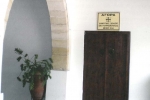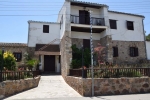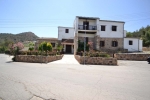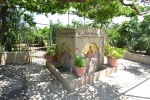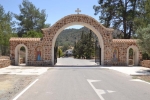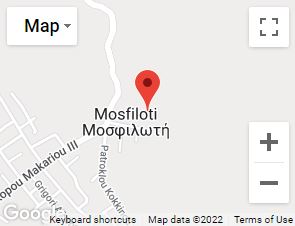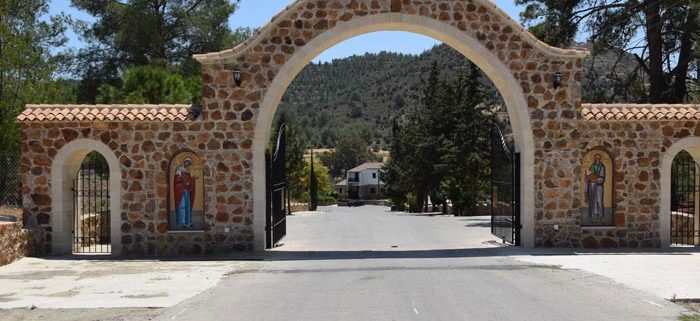
TRADITION
The Holy Monastery of Agia Thekla is located about 500 meters south of the Mosfiloti village of Larnaca’s District. It is built in the middle of a small, verdant valley, in a venue that provides the necessary peace for the monastic community that abides in it.
Spiritually it comes under the Hole Archdiocese of Cyprus along with the monasteries of Saint Herakleidios, of Saint Panteleimonas, of Achera, of Archangel Michael, of Saint Kendeas, of the Transfiguration,, and of the Virgin Mary, one of the seven convents of the Archiepiscopal district.
According to tradition, which was recorded by the British traveler William Turner in 1815, the monastery of Saint Thekla was built by Saint Helen during her visit to Cyprus in the beginning of the 4th century AD, when she had also established the Holy Monastery of Stavrovouni. The relevant tradition reports that Saint Helen arrived at the region where the monastery stands today, prayed to God and then Holy Water started flowing from the earth that helped her and her escorts to cool down. She then constructed a church over this spot, which she dedicated to the early martyr and equal to Apostles, Saint Thekla.
The Holy Water spring exists today and it is used by the faithful for the cure of skin diseases and eczemas.
In the trail through which Saint Helen and her Escort passed, next to the monastery, there were -until recently -trees of an oblique shape. A sort of certification by nature that bowed as the Saint was passing by.
HISTORY
The oldest known reference to the Holy Monastery of Saint Thekla comes from 1780, in a special page of the Land Codex of Cyprus’s Holy Archdiocese where -under the title ‹‹Of the Agia Thekla Monastery›› -some Holy Vessels and some other objects belonging to the church are recorded. There are several references to the goods & chattels and the realty of the Monastery in both the 1780 Land Codex and in an earlier codex of the year 1773.
Quite significant are the information we have, regarding the History of the Monastery, in the beginning of the 19th century. The first relevant report comes from the 1800’s Second Register, which is kept in the archives of Cyprus’s Archdiocese, where the names of five monks are recorded, these monks constituting the monastery’s sodality. Three of them came from the village Mosfiloti, one of them from Psevdas, while the origins of the other one were not recorded.
Six years later, in 1806, when the Spanish traveler Ali Bey (1767-1818) visited the Monastery, he met there only one monk and some servants, which were occupied with the cultivation of its estates.
Two British travelers, the military man Henry Lite and William Turner, who had visited Cyprus in 1814 and 1815 respectively, provide several additional elements regarding the Monastery’s history.
In his relevant text, Henry Lite mentions that s priest abided in it along with two or three servants that were occupied with the preparations for the celebration in honor of Saint Thekla, which was going to take place in a few days. The poverty and misery that prevailed amongst the region’s rural population, indicative of the troubles and the hardships that Cyprus’s Greeks suffered during the years of Turkish domination, made a strong impression on the British traveler. In his text he also notes that the Monastery’s priest could not read well but knew the words of the mass by heart. In that way Henry Lite indirectly provides us with another significant information, regarding the low level of education of the people in those difficult times. Besides, the only school operating in Cyprus in the beginning of the 1810’s was the Hellenic School of Nicosia, which opened its gates in 1812 after an initiative by the -then -Archbishop Kyprianos (1810-1821). Also of interest is the information regarding the existence of frescoes inside the church, which by that time were already destroyed.
A year later, on the 6th of October 1815, the Monastery of Agia Thekla was visited by William Turner, who -among other things -also reports the relevant oral tradition about the Monastery’s establishment by Saint Helen.
Because of the feast for Saint Thekla’s day, many Greek villagers from all over the island must have been present and so he happily accepted the invitation from Mr Peristianis, the Consul of Russia, to have dinner at his country house in the village and see the fair from up close.
During his visit he was impressed by the beautiful area around the Monastery, as well as with the Greek villagers that wore their nicest attires with various colours, sitting and eating, drinking and playing their mandolins -some sort of a guitar -singing and dancing.
The Holy Monastery of Agia Thekla celebrates on the 24th of September, the day that our Church honours the memory of the great Martyr and Equal to Apostles, Saint Thekla. On this day, one of the largest fairs in the Larnaca district takes place. A swarm of pilgrims from all over Cyprus visit the Monastery so as to pray and celebrate. During older times there were many ovens in the region, which -necessarily -were baking the “ofto kleftiko” (roasted mutton) for that day’s revelry.
It is reported that William Turner visited the Monastery on the 6th of October that today really corresponds to the 24th of September, because of the fact that -before 1924 -the countries of Western Europe observed a different calendar than that of the Orthodox East.
The last known reference to the Monastery of Agia Thekla comes from 1825’s Sixth Register of the Holy Archdiocese of Cyprus, where it is mentioned as one of the 31 Monasteries that belonged to the Archiepiscopal district. In that year, the Monastery’s order consisted of five monks, the two of them being natives of Mosfiloti, one of Sia, one of Louroutzina, and one of Kornos. A few years later the Monastery dissolved, probably because of the long-term consequences that the tragic events of July 1821 had on the ecclesiastic life of Cyprus. Besides, in that same period many other Monasteries in the island were abandoned since the Ottoman conquerors focused their anger on them, aiming to deprive the Greeks of Cyprus from its spiritual centres.
In the years that followed, the estates of the Monastery were leased to inhabitants of the surrounding villages by the Archdiocese. One of them was Church Steward Ioanikios from Mosfiloti, who -in 1867 -arranged for the decoration of the Saint Thekla’s icon and kneeling desk. More specifically, Ioannikios. In particular, while Ioannikios was irrigating the Monastery’s plantations, he noticed that the ground subsided at some spot and it absorbed a significant amount of water. He then crossed himself and exclaimed, ‹‹Saint Thekla, if I find something, I will cover you with gold››. Indeed, when he dug in that venue he discovered a clay pot filled with golden, Venetian coins -a fact that allowed him to fulfil his solemn promise. He then invited the artisan Hadjigiannis who made the cover of the icon and engraved the relevant sign, ‹‹Expenses generously paid by the supervising Church Steward Ioannikios Papageorgiou 1867››.
Six representations from Saint Thekla’s life are included upon the icon’s silver cover. Originally the icon had a crown decorated with silver, which was a donation by the nation’s martyr Kypros Kyprianou in 1816. ‹‹Oh, Thekla, accept this crown as a gift, which is brought to you by Kyprianos Kyprou A-Ω-Ι-ΣΤ’››. Ioannikios made provisions so that the crown would be placed onto the Saint’s icon, where it is until today.
For the making of the icons, other donators contributed too, such as Flourou, Constantas, Vasilou, and others that are mentioned in the signs.
By the end of the Turkish domination era, a Greek school operated in the Monastery’s Synodikon, attended by about fifty children from the villages Mosfiloti, Sia, Kornos, Pyrga, Psevdas, and Agia Anna. Among others, Nikolas Chiotis from the island of Chios, Antonis Efstratiou from Pyrga, Emmanuel Christofidis from Lympia, the teacher Chrysostomos from Agia Varvara, and Constantinos Kypraios and Ioannis Kasoulidis from Nicosia taught in it. This fact was formerly reminded by a faded sign that was on the door of the old Synodikon and which today has been replaced by another -more distinct -one. The school continued its operation until 1914 when the elementary school of Mosfiloti was established.
Several years later, in 1965, some monks who observe the old calendar, having permission by Archbishop Makarios III (1913-1977), settled in the monastery after the destruction of their own and the murder of three members of their order by Turkish fanatics on the 1st of January 1964. Fourteen years later, in 1979, they withdrew and so the monastery remained without tenants once again.
In very recent years the Monastery of Agia Thekla reopened, this time as a convent. The Sisters Constantia and Evlogia settled in it on the 9th of November 1991, the two of them formerly being members of the order of St George of “Alamanos” and the convent of Mount Sina. The number of the women living the monastic life then increased with more nuns joining their order. Today (2004) nine nuns are living in the monastery with Sister Constantia as the prioress.
THE LIFE OF THE PROTO-MARTYR AND EQUAL TO APOSTLES, SAINT THEKLA (BY SAINT NIKODIMOS OF MOUNT ATHOS)
Saint Thekla was the daughter of Theokleia from Ikonio and -at the age of 18 -she was engaged with someone called Thamyri. When Apostle Paul went from Antiocheia to Ikonio, he stayed at the house of Onisiforos and there he taught faith in Christ to all those who went to him. Saint Thekla was living in the same neighbourhood and whenever she listened to the sweet words of Paul she forgot about eating, drinking, and whatever else is necessary for survival. She even forgot about her mother and her fiance, although they wee both trying to stop her from listening to the words of Paul. When Paul was imprisoned, Saint Thekla went at night to listen to the teachings of the Apostle and followed him ever since then. Because they both resisted to the Roman vice-consul, Paul was beaten and driven away from Ikonio, while Thekla -with the help of God -escaped from the fire she was thrown in and started searching for the Apostle. She found him hiding inside a grave along with Onisiforos, his hotel’s keeper, and went with him to Antiocheia. As soon as they entered the town, Alexander -the premier nobleman of Antiocheia -fell in love with Thekla. Because he begged Paul so that he would take her as his wife and failed, he then grabbed her and shamelessly kissed her in the middle of the road. The Saint started shouting and ripped the nobleman’s cloak, threw the chaplet he was wearing away and was asking for Paul only. Alexander, not being able to stand such an embarrassment, reported Thekla to the local ruler. Then the martyr was given as food for a lioness and then to both lions and bears. However, without anything happening to her, she entered a pit filled with water that she saw, long since wanting to be baptised. All the seals that were in it died -through divine intervention. The maiden was again given to the wild beasts. The women that were around there were reproaching the ruler for punishing an innocent woman and showed great love for Thekla. Especially a relative of Caesar, Tryfaina, which protected her and treated her like she was her daughter Falconilla that had died.
Thereafter, the Saint was tied up close to two terrific bulls that belonged to Alexander. But she remained unharmed even from them. The ruler and the nobleman Alexander contemplated that they were trying for what is impossible and -also seeing the courteous Tryfaina fainting from feeling so much sorrow for Thekla’s travails -released the Saint, to live her life any way she wants.
After the Saint’s release and after some time had passed, she went to Myra and found Paul. From there she -again -returned to Ikonio and with the consent of Paul she started teaching the Gospel to the infidels. Because she saw that her mother did not believe in the words of the Gospel, she left her and went to Ikonio, at the grave where she had found Apostle Paul along with Onisiforos. She bowed in adoration before it and then went to Selefkia (Seleucia / Silifke). She went a mile outside the town and climbed up the Kalamon Mountain, inhabiting a cave. There she was many times teased by demons. She became known to everyone for her virtues and her miracles, drawing many women of noble and lordly status into mimicking her in the ascetic life. Because the Saint functioned as an unpaid physician for everyone, the doctors of Selefkia envious and so they sent some young men to dishonour her. When the Saint saw them attacking her in shameless manner, she invoked God’s help. Then -as if by a miracle -she heard a divine voice telling her to enter inside a stone, which was torn apart for her and there she rested -forever close to God -at the age of 90.
MIRACLES OF SAINT THEKLA
Only two recent miracles, out of the many miracles of Saint Thekla, are characteristically recorded here.
Rashes (in the Cypriot dialect “karfites”) affected Panagis Hadjiionas in both of his feet at a young age, resulting in great suffering, especially when he walked.
He went to the doctors, used salves -but to no avail. One day, as he was returning from Stavrovouni along with his brother Vasilis -the journey from Lysi to Stavrovouni was always done on foot -they stopped at the Holy Monastery of Saint Thekla to bow before her icon. There he took some mud from the Saint’s Holy Water spring and rubbed some of it on his feet. By the time they reached Lysi, all the rashes had disappeared from both of his legs. At a an older age and after the Turkish invasion, while being a refugee, another rash -a “karfitis -appeared on his nose. Again he took some mud from Agia Thekla and after rubbing it in the affected area the illness disappeared.
He often referred to the miracle so as to reflect God’s power. This mucky soil, he used to say, can achieve what doctors and scientists cannot. God, even through such useless materials can perform miracles.
With the grace of our Lord and the blessing of my spiritual guide, I will present to you a miracle of our Lord, who -through the mediation of Saint Thekla and in spite of my sins -benefited me.
I was suffering for about two years. I had sarcomas on both my hands. I went to doctor P.S. He told me “there is no cure but I can give you some searing liquid so that you will be cauterising them”. When I did so, more of them appeared. On the 24th of September, that is the day the Church celebrates the memory of Saint Thekla, I went to the Monastery in Mosfiloti and attended the liturgy. It was a Sunday. After chanting, we carried the Saint’s icon in procession. Through the Holy Communion I received the grace of God. When I was about to leave, I placed some mud on my hands. Ever since then I am cured and never again has such a problem occurred to me. I thank the lord for being healed. I also want to thank Saint Thekla for I believe that I benefited through her mediation.
